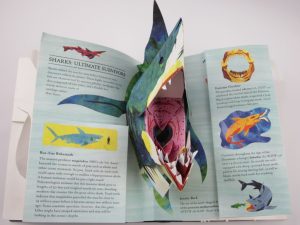Robert Sabuda’s Sharks
Listen to the Recess! Clip
| Author | John Cech |
| Air Date | 6/1/2006 |

Robert Sabuda’s Sharks Transcript
I don’t know about you, but I’m absolutely giddy over pop-up books — or any books that have moveable parts or some other tactile inventions. They can be simple, even rudimentary, like a flap that lifts to reveal a picture underneath, and they’ll have my attention. There’s something about the constantly renewing sense of surprise that keeps me going. And if the books are as clever as Robert Sabuda’s — well, then I can be gone for hours, trying every tab, trying every page dozens and dozens of times to see the flat paper suddenly open up into something extraordinary. Like the spectacular, see-through skeleton of the kronosaurus that occupies the middle of the new book that Sabuda has done with Matthew Reinhart. It’s called Encyclopedia Prehistorica: Sharks and Other Sea Monsters, and it follows fast on the scaley heels of last year’s tour de force by Sabuda and Reinhart, Dinosaurs, The Definitive Pop-Up.
Sharks and Other Sea Monsters is not simply an occasion to present a half dozen mini-masterpieces of paper engineering — though it does just that. From the large, red pterygotus (TAIR-ih-GO-Tus) that looks like a cross between a lobster and a scorpion, to the prehistoric whale called the basilosaurus (BASS-ih-lo-SAWR-us) that was mistaken for a sea serpent, Sabuda and Reinhart have brought their very best game. Plesiosaurs (PLEE-zee-uh-SAWRS), elasmosaurses (eh-LAZ-mu-SAWR-uses) and mosasauruses (MO-Zuh-SAWR-uses) are all tangled together in one frantic composition of mezozoic necks and flippers and teeth. One almost can’t imagine how such a piece of sculptural paper was ever glued together in the first place, let alone mass produced and made durable enough to withstand the pulls and tugs of little post-pleistocene hands. But they have.
And woven in and out of the six large, pop-ups themselves are mini pop-ups that open like books, literal sub-texts, from the corners of the pages to take the reader deeper into the pre-history of the geologic era, eons ago, that produced these astonishing creatures that dominated their ocean world and that would ultimately leave the water to walk on land and become the dinosaurs. The process took hundreds of millions of years, we learn, and yet the reader feels the time moving nimbly here, through Sabuda’s and Reinhart’s deft guidance, as sleek and sharply drawn as the ancient shark that inspires the title of the book. Science meets art meets magic on these pages. And both your young dinosaur fans and you will be held, happily enthralled by this encounter with paper come alive.
Explore This Topic Further